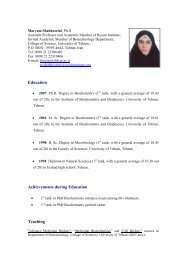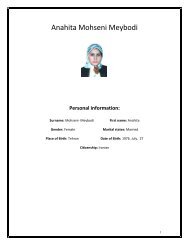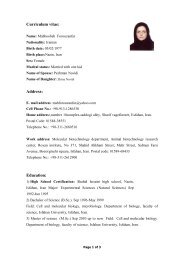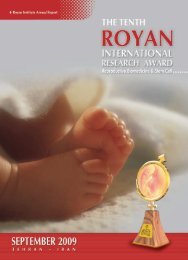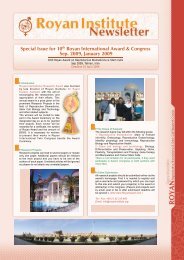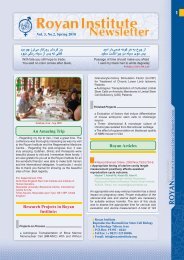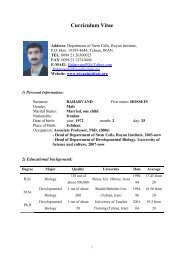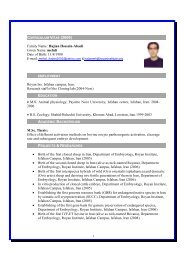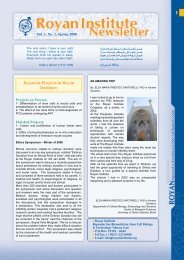Royan International Research Award - Royan Institute
Royan International Research Award - Royan Institute
Royan International Research Award - Royan Institute
- No tags were found...
You also want an ePaper? Increase the reach of your titles
YUMPU automatically turns print PDFs into web optimized ePapers that Google loves.
The Eleventh ROYAN<strong>International</strong> <strong>Research</strong> <strong>Award</strong>WINNERSNationalWinnerStem Cell Biology & TechnologyNational Winner WinnerDifferentiation capability of mouse bonemarrow-derived mesenchymal stem cells intohepatocyte-like cells on artificial basementmembrane containing ultraweb nanofibers andtheir transplantation into carbon tetrachlorideinjured liver modelAbbas Piryaei, PhDIranAbbas Piryaei obteined his PhD in Anatomical sciences from Tarbiat Modares universuty, Tehran, Iran. Since 2001, he has been amember of cell and molecular biology research center, and he is currently assistant professor of medicine school of Shaheed Beheshtimedical sciences university. Also he is collaborating with stem cells and developmental biology department of <strong>Royan</strong> institute, and since2004 he has been manager of histology laboratory of the institute. Dr. Piryaei`s research intrest include ultrastructural study of livingorganisms tissues, and also stem cell biology, especially mesenchymal stem cells and their differentiation in vitro and in vivo.Objective:Liver fibrosis, the wound-healing response of the liver to chronic injury, is one of the most problems in health care. Atpresent, liver transplantation is the only curative therapy available for the patients; however, there are various problems withthis approach, including donor shortages, surgery related complications, immunological rejection, and high cost. Recentstudies showed that regeneration therapy has the potential to become a useful minimally invasive technique with minimalcomplications. Bone marrow mesenchymal stem cells (BM-MSC) have been shown to be capable of differentiating into aliver cell lineage in vitro and in vivo. However, MSC differentiation to hepatocyte is poor, and the cell characteristics andtheir role in liver repair are poorly understood.Material and Methods:we differentiate mouse BM-MSCs into early (day 18) and late (day 36) hepatocyte-like cells (HLCs) in vitro in presence orabsence of ultraweb nanofibers (nano+ and nano-). Then we evaluated their hepatocyte specific genes and proteins by RealtimePCR and immunofluorescence. We also evaluated ultrastructure of the differentiated cells by electron microscope andexamined their functionality by PAS and PROD techniques and measurement of hepatocyte specific secretions in culturemedium. Then we investigated potential of the untreated MSCs and the early and late HLCs of nano+ and nano- groups forrecovery of mice with CCl4 induced hepatic fibrosis.Results:We have demonstrated that, the markers of hepatocytes-albumin (ALB), HNF4α, CX32 and CYP1A1- were upregulatedconsistently in a time-dependent manner in the nano+ group, but not changed or decreased in nano- group. Moreover, theurea production, secretion of ALB and α-fetoprotein, and metabolic activity of the CYP450 enzymes were significantlymore within differentiated HLCs on nanofibers in vitro at day 36. MSCs and early and late HLCs in nano+ and nanocultureconditions, transplanted by intravenous route, decreased liver fibrosis, engrafted in recipient liver, and differentiatedinto functional hepatocytes (ALB+), except late HLCs in nano- group.Conclusion:These results showed that transplantation of late HLCs of nano+ group was more effective in rescuing liver failure,enhancement of serum ALB, homing of transplanted cells, and functional engraftment, than other groups. It seems thattopographic properties of nanofibers enhanced hepatogenic differentiation profile and maintain the function of MSCderivedhepatocytes in long-term culture, which has implications for cell therapies.Keywords:Mesenchymal stem cells; Hepatocyte-like cells; Nanofibers; Liver fibrosis; Differentiation43



